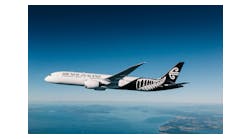Airbus CEO Guillaume Faury said Thursday that while the outlook for an aerospace rebound remains complex globally, the outlook for the U.S. is “quite bullish and looking for a very strong summer” and that a ramp-up in demand for single-aisle jetliners, such as those it builds in Alabama, “is coming sooner now.”
Faury spoke Thursday during a conference call on the company’s first-quarter financial results. While optimistic, Faury’s remarks also were cautious. For the remainder of 2021, the company isn’t escalating production plans beyond what it had already forecast. The company aims to deliver the same number of commercial aircraft as it did in 2020.
“Based on everything we see today, we keep our guidance unchanged,” he said. He went on to explain that what the company sees is a fragmented world where some countries are recovering from the COVID slump more quickly than others, and some are struggling to make forward progress.
“Global air traffic started weaker in 2021 than industry forecasts,” he said. “This weakness was driven by deterioration in most international markets, including domestic China, where citizens were requested to stay at home during the traditional Chinese New Year travel period.” Since then, domestic travel in China has rebounded strongly, he said. Signs are positive in North America, he said, but Europe is “considerably lagging behind.”
“International traffic globally remains at a very low level, and the recent decay in the sanitary situation in India reminds us of the fragility of the recovery,” he said.
The company still expects full recovery to pre-COVID air traffic levels will come somewhere between 2023 and 2025, Faury said.
In a potential positive sign for Airbus’ U.S. jetliner assembly operations in Mobile, Faury said he expects demand for single-aisle jets to increase “sharply” in 2022.
Airbus assembles the single-aisle A320 family in Mobile as well as the newer, smaller single-aisle A220 family. In 2019 the company was cranking out 60 A320s a month, the combined output of Mobile and three other locations, and was aiming to increase production rates even more. By contrast its current rate is about 40 per month with plans for slow growth to 45 per month by year’s end.
Single-aisle jets, particularly long-range versions, are expected to be in demand as passenger traffic slowly returns to pre-COVID levels. The demand for widebody jets is expected to return much more slowly.
Faury said the challenge is “preparing the single aisle ramp-up to be ready for when the market recovers, and that’s coming sooner now.” To capitalize on the increased demand it expects to see next year, Airbus is making efforts to ensure that its suppliers are ready with the necessary engines and other components, he said.
In response to a question about the A220, Faury confirmed the program has not yet reached its break-even point.
“We’ve always said that we need to ramp basically both factories in Mobile and Mirabel [Canada] to a decent loading level to come to break-even operationally,” said Faury. “Now that’s the key question, how quickly can we do that? You can make the math, you will see that to come to full load it will probably be some 170 or so a year. But we don’t need all that, we probably need probably slightly less than that to come to break even. And it will take us several years to get there, because you know the rates we currently have are much lower than that.”
According to its 2020 summaries, Airbus delivered 38 A220s last year compared to 446 A320s. The young program is still building momentum, and it was June 2020 before the Mobile assembly line’s first Alabama-built A220 made its first flight. That jet was delivered to Delta in October.
Airbus has reported delivering 38 A220s in 2020 and 9 in the first quarter of 2021. Those figures do not break down how many were built in Mobile and how many in Quebec.
In a February interview with the Globe and Mail, Faury spoke in more detail about the A220 program’s course to profitability. According to that report, the maximum anticipated production is 14 per month or 168 per year, with break-even expected mid-decade.
©2021 Advance Local Media LLC. Visit al.com. Distributed by Tribune Content Agency, LLC.




